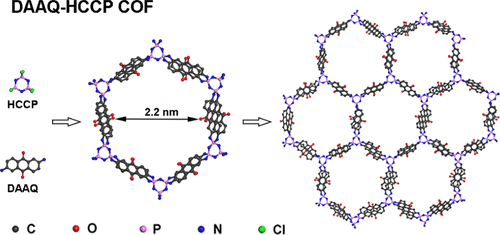当前位置:
X-MOL 学术
›
Energy Fuels
›
论文详情
Our official English website, www.x-mol.net, welcomes your
feedback! (Note: you will need to create a separate account there.)
Anthraquinone-Based Covalent Organic Framework Nanosheets with Ordered Porous Structures for Highly Reversible Sodium Storage
Energy & Fuels ( IF 5.2 ) Pub Date : 2020-12-30 , DOI: 10.1021/acs.energyfuels.0c04165 Ming-Ming Hu 1 , Huawen Huang 1 , Qiang Gao 2 , Yan Tang 1 , Yuwen Luo 1 , Yuanfu Deng 1 , Lei Zhang 1
Energy & Fuels ( IF 5.2 ) Pub Date : 2020-12-30 , DOI: 10.1021/acs.energyfuels.0c04165 Ming-Ming Hu 1 , Huawen Huang 1 , Qiang Gao 2 , Yan Tang 1 , Yuwen Luo 1 , Yuanfu Deng 1 , Lei Zhang 1
Affiliation

|
Incorporating redox-active quinones with linkers to form covalent organic frameworks (COFs) could effectively improve their electrochemical performances when used as electrode materials. Their stable frameworks are able to inhibit dissolution of quinone in the organic electrolyte, and ordered porous structures enhance the ion diffusion rate. Condensing redox-active quinones with linkers containing more replaceable sites could increase the redox-active moieties in COF electrode materials, which would effectively increase their specific capacities. Herein, 2,6-diaminoanthraquinone (DAAQ) was condensed with the hexachlorocyclotriphosphazene (HCCP) linker containing six replaceable sites of −Cl to form ordered porous DAAQ–HCCP COF. All of the −Cl sites of the HCCP linker were replaced by redox-active DAAQ during condensation reaction, significantly increasing the content of electroactive moieties in the framework. Benefiting from the stable framework and ordered porous structures, DAAQ–HCCP COF exhibits higher cycling stability than DAAQ and outstanding rate performance when used as the anode for sodium-ion batteries. The prepared COF displays specific capacities of 88 mA h g–1 at 100 mA g–1 after 100 cycles and 72 mA h g–1 at 2000 mA g–1 after 1000 cycles. The present work provides a new strategy to design COF with more redox-active sites for organic rechargeable batteries.
中文翻译:

蒽醌基共价有机骨架纳米片具有高度可逆的钠存储的有序多孔结构
当用作电极材料时,将氧化还原活性醌与接头结合形成共价有机骨架(COF)可以有效改善其电化学性能。它们稳定的骨架能够抑制醌在有机电解质中的溶解,并且有序的多孔结构可提高离子扩散速率。用含有更多可替换位点的接头缩合氧化还原活性醌可以增加COF电极材料中的氧化还原活性部分,这将有效地提高其比容量。在此,将2,6-二氨基蒽醌(DAAQ)与含有-Cl六个可替换位点的六氯环三磷腈(HCCP)接头缩合,形成有序的多孔DAAQ-HCCP COF。在缩合反应过程中,HCCP接头的所有-Cl位点均被氧化还原活性DAAQ取代,大大增加了框架中电活性部分的含量。得益于稳定的框架和有序的多孔结构,DAAQ–HCCP COF用作钠离子电池的负极,其循环稳定性高于DAAQ,并具有出色的倍率性能。制备的COF的比容量为88 mA汞柱100个周期后为–1,在100 mA g –1下; 1000个周期后,为72 mA hg –1,在2000 mA g –1下。目前的工作提供了一种新的策略来设计具有更多氧化还原活性位点的有机可充电电池。
更新日期:2021-01-21
中文翻译:

蒽醌基共价有机骨架纳米片具有高度可逆的钠存储的有序多孔结构
当用作电极材料时,将氧化还原活性醌与接头结合形成共价有机骨架(COF)可以有效改善其电化学性能。它们稳定的骨架能够抑制醌在有机电解质中的溶解,并且有序的多孔结构可提高离子扩散速率。用含有更多可替换位点的接头缩合氧化还原活性醌可以增加COF电极材料中的氧化还原活性部分,这将有效地提高其比容量。在此,将2,6-二氨基蒽醌(DAAQ)与含有-Cl六个可替换位点的六氯环三磷腈(HCCP)接头缩合,形成有序的多孔DAAQ-HCCP COF。在缩合反应过程中,HCCP接头的所有-Cl位点均被氧化还原活性DAAQ取代,大大增加了框架中电活性部分的含量。得益于稳定的框架和有序的多孔结构,DAAQ–HCCP COF用作钠离子电池的负极,其循环稳定性高于DAAQ,并具有出色的倍率性能。制备的COF的比容量为88 mA汞柱100个周期后为–1,在100 mA g –1下; 1000个周期后,为72 mA hg –1,在2000 mA g –1下。目前的工作提供了一种新的策略来设计具有更多氧化还原活性位点的有机可充电电池。


















































 京公网安备 11010802027423号
京公网安备 11010802027423号